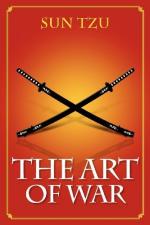|
This section contains 383 words (approx. 1 page at 400 words per page) |

|
The Art of War Summary & Study Guide Description
The Art of War Summary & Study Guide includes comprehensive information and analysis to help you understand the book. This study guide contains the following sections:
This detailed literature summary also contains Bibliography on The Art of War by Sun Tzu.
Sun-Tzu's The Art of War (Sun-tzu ping-fa), unlike other contributions of war literature, is not a fictional or otherwise indirect account of warfare. Rather, it is one of the first known treatises on military strategy in human history and continues to be one of the most studied and enduring of such writings.
Not much certainty exists for its date of composition, though most scholars place it during the Warring States period (403–221 B.C.) of Chinese history. In Battle: A History of Combat and Culture, military historian John A. Lynn equates the period with endless warfare, when "perhaps 110 states ceased to exist." It was a "long, brutal, and destructive" period, writes military historian Ralph Peters in "The Seeker and the Sage," but one that nonetheless "bloomed with creativity," the work of Sun-Tzu not being the least of its accomplishments. Some, alternatively, have claimed that Sun-Tzu was a contemporary of Confucius (551–479 B.C.), but this date for the text of The Art of War is generally rejected. Because of internal stylistic evidence, the date of composition is now tentatively set as 400–320 B.C.
In terms of the long history of military theory, Sun-Tzu stands somewhat apart from the later debate because he emphasizes war as a last resort and characterizes this last resort as itself a significant defeat. He has, therefore, earned the reputation of being a pacifist who prefers diplomatic resolutions and espionage to the open and total warfare of other theorists, such as Karl von Clausewitz, author of On War (1832). Within the themes of war and peace, Sun-Tzu thus takes a place at the head of the table; his strategy overall is a complex discussion of the necessity of both peaceful resolutions and warlike aggression, opposites he presents as constantly tense, much like the yin and yang ("shady" and "sunny") of classical Chinese philosophy. As such, the text informs any serious discussion of the representations of warfare in literature.
Military theorists tend to consider the centuries-old text useful still, especially in an era dominated by war on terrorism. While most commonly called The Art of War, some editions refer to the text as The Art of Warfare, as does the Modern Library War Series The Book of War (2000), which includes both Sun-Tzu's and Clausewitz's text, as well as numerous supplemental materials.
Read more from the Study Guide
|
This section contains 383 words (approx. 1 page at 400 words per page) |

|



